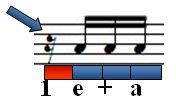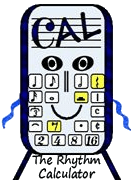



The SIXTEENTH REST
The Sixteenth Rest equals the duration of a Sixteenth Note: 1/4 a BEAT.
Sixteenth Rests have Two Arcs, just like a Sixteenth Note’s Two Flags or Beams.
It is rare to see many Sixteenth Rests in a row. Most often, rests of higher-beat value fill longer silences.
Count and sub-divide each beat as: 1e+a, 2e+a. 3e+a, 4e+a.
Red lines represent sixteenth rest silences and blue lines show the notes you play.
Most frequently, Sixteenth Rests land on the beginning of a beat.
Sixteenth Rests help to add intensity to musical passages by forming active rhythmic patterns.

Play example

Meet Cal Universal Language Rhythm Notation Music Staff Origins of the Staff
Rhythm Laboratory Notation Parts Note Heads Stems Beams Flags Note Construction
Common-Time Measures Bar-Lines Counting in Common-Time Whole, Half and Quarter Notes
Ties Dots Time-Signatures Q’s Rhythm Review Time-Signature Rules Beat Accent
Down-Beat and Up-Beat Conducting Patterns Cut-Time Common-Time Beat Emphasis
Three-Beat Measures Note Values Rhythm Workouts The ‘Cycle’ Note Equivalents
Counting Sub-Divisions “If You Can Say It, You Can Play It” Author’s Story Sub-Division Lingo
Quarter Notes with Eight Notes Adding Sixteenth Notes Notes Sharing Beams Beam Awareness Pointers
Triplets Triplet Workout Compound-Time Compound-Time Workout Music Rests
Rest and Note Equivalents Whole Rest Half Rest Quarter Rest Eighth Rest Sixteenth Rest
Dotted Rests Q’s Rest Review Process of Sub-Division Relating Rests to Notes Rhythm Exam Prep
Level 1 Rhythm Exam Level 2 Rhythm Exam Level 3 Rhythm Exam
Rhythm Laboratory Notation Parts Note Heads Stems Beams Flags Note Construction
Common-Time Measures Bar-Lines Counting in Common-Time Whole, Half and Quarter Notes
Ties Dots Time-Signatures Q’s Rhythm Review Time-Signature Rules Beat Accent
Down-Beat and Up-Beat Conducting Patterns Cut-Time Common-Time Beat Emphasis
Three-Beat Measures Note Values Rhythm Workouts The ‘Cycle’ Note Equivalents
Counting Sub-Divisions “If You Can Say It, You Can Play It” Author’s Story Sub-Division Lingo
Quarter Notes with Eight Notes Adding Sixteenth Notes Notes Sharing Beams Beam Awareness Pointers
Triplets Triplet Workout Compound-Time Compound-Time Workout Music Rests
Rest and Note Equivalents Whole Rest Half Rest Quarter Rest Eighth Rest Sixteenth Rest
Dotted Rests Q’s Rest Review Process of Sub-Division Relating Rests to Notes Rhythm Exam Prep
Level 1 Rhythm Exam Level 2 Rhythm Exam Level 3 Rhythm Exam



